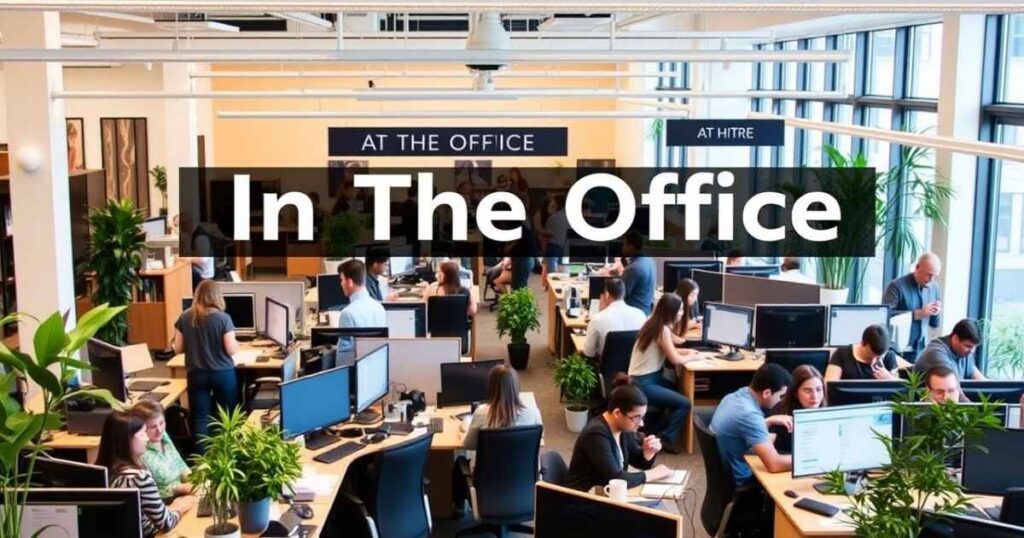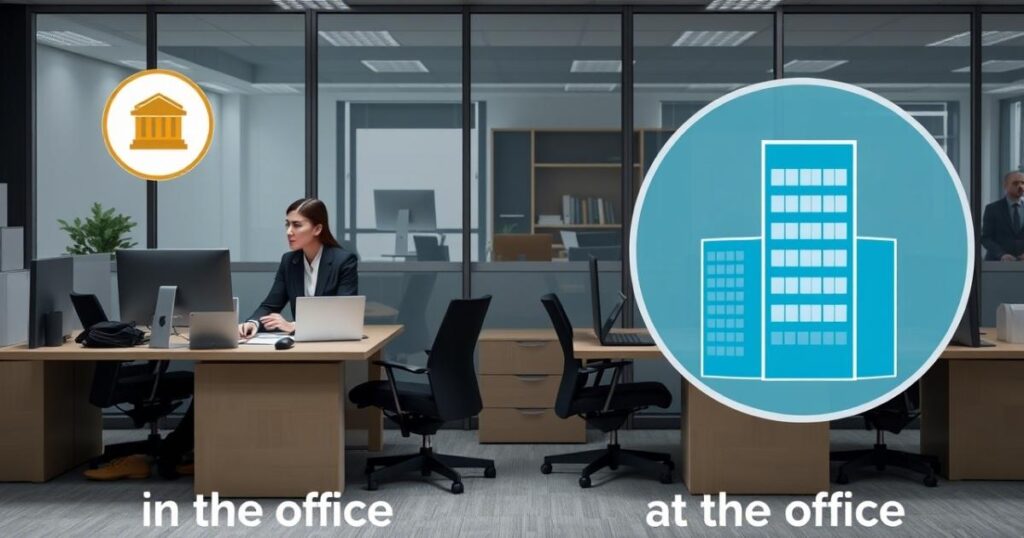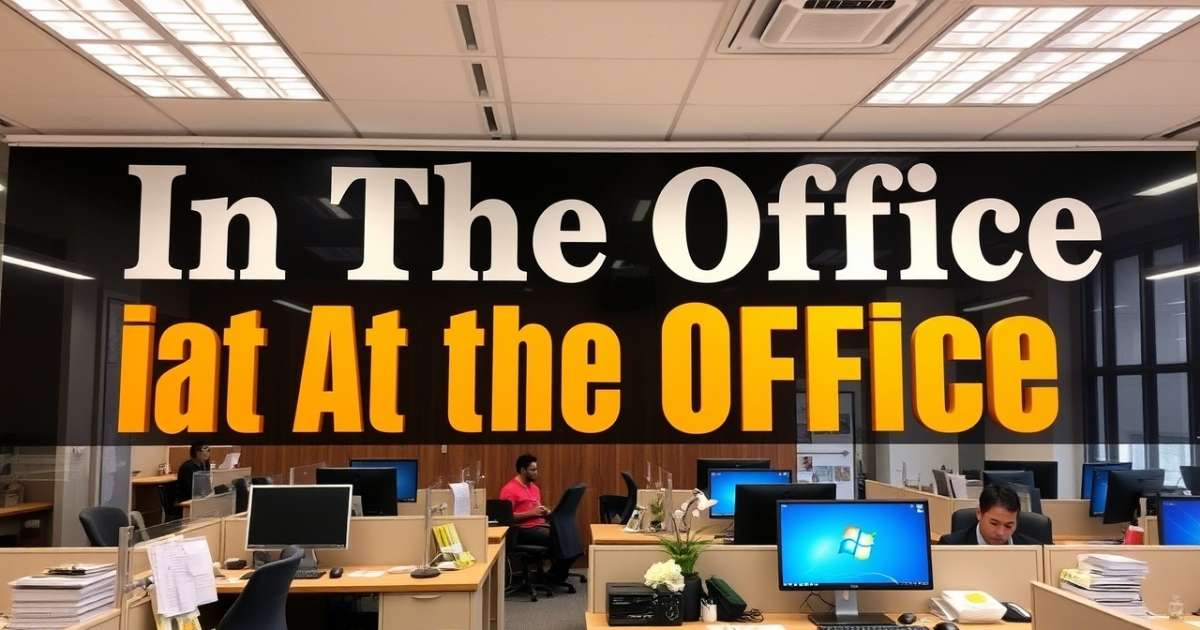Ever found yourself wondering whether to stay in the office or at the office? It’s a common question when talking about your work environment. While both phrases are often used interchangeably, they have slight differences. Saying “I am in the office” typically means you’re physically inside the office building. It’s clear and direct. On the other hand, saying “I am at the office” can simply mean you’re at the office location, but not necessarily inside. You might be outside or near the entrance, still at your work destination.
Even though both phrases seem similar, they help paint a more precise picture of where you are. Whether you prefer, the important thing is that you’re present and ready for work. It all comes down to your personal preference!
which one is right In The Office or At The Office? What’s the main answer?
When it comes to workplace communication, “in the office” and “at the office” are two phrases that often spark confusion. While both phrases are commonly used, there are important nuances that differentiate them. Understanding the subtle distinctions between these two terms can enhance the clarity of your communication, whether you’re discussing your physical presence at work, your availability, or your work routine. This can be particularly helpful in today’s workplace, where the lines between office work, remote work, and hybrid work are increasingly blurred.
The phrase “in the office” specifically refers to being physically inside the office building. It’s a precise term used to describe a person who is working within the office’s walls, such as sitting at a desk, attending a meeting, or collaborating in person with colleagues. If someone says, “I am in the office,” it indicates that they are currently inside the workplace environment, engaging in work-related activities in the office space.
On the other hand, “at the office” is a broader and more flexible phrase. It refers to being present at the office location but doesn’t specify whether you are inside the building. For instance, when someone says, “I am at the office,” they may be standing in the office parking lot, waiting near the entrance, or even just walking to the building from the nearby bus stop. The phrase “at the office” doesn’t necessarily mean you are inside the building, it only indicates that you are at the office location, regardless of whether you are physically within the office.
This distinction becomes even more important when considering the evolving work environment, especially with the rise of remote and hybrid work. With many employees now splitting their time between working remotely and working from the office, understanding the difference between “in the office” and “at the office” helps clarify exactly where someone is when discussing their availability.
In today’s world of flexible schedules and remote work options, the distinction between “in the office” and “at the office” is crucial. Many companies have adopted hybrid work models, where employees work part of the time from home and part of the time in the office. In such a scenario, saying you’re “at the office” might not mean that you’re inside the office building but rather that you’re at the office location, possibly in the parking lot, preparing to enter, or standing outside on a break.
In these cases, “at the office” provides more flexibility than “in the office,” which has become a more rigid term. For example, if you’re working remotely and decide to meet a colleague for lunch at the office, you could say you’re “at the office,” even if you don’t enter the building itself. The phrase “in the office” would be reserved for situations where you’re physically working inside the office.
The distinction between “in the office” and “at the office” is more than just a matter of semantics. It’s about providing clarity to colleagues, supervisors, and clients about your whereabouts and availability. In a traditional office setup, the phrase “in the office” was commonly used because most employees were expected to be physically present inside the building. However, with the rise of remote and hybrid work, the phrase “at the office” has gained more relevance because it reflects a broader scope of being present at the office location, regardless of whether you are inside the building.
For instance, if you’re working from home but have an appointment or meeting at the office, you may not be physically inside the building but still need to inform your team that you’re headed to the office. In this case, “at the office” gives others a clear understanding that you are on your way or present at the office location, even if you’re not inside it.
The key to choosing the right phrase comes down to context. If you’re actively working inside the office building, use “in the office”. If you’re nearby, outside, or in the parking lot, but still on the premises, “at the office” is the more appropriate phrase. These distinctions matter as they help clarify your exact location and work routine, especially in a hybrid work environment where colleagues might have different schedules and office arrangements.
Understanding when to use “in the office” versus “at the office” helps streamline communication, particularly when discussing your availability or presence. It ensures that everyone in the workplace is on the same page and avoids confusion. Both phrases are essential in today’s modern workplace, where flexibility and remote work have become the norm for many employees.
In conclusion, while “in the office” and “at the office” are similar, they are not interchangeable. Each phrase has its specific meaning depending on the context. Knowing when to use each one can ensure clear communication about your whereabouts, availability, and work routine, especially in the age of hybrid work and flexible schedules.
1. Physical Presence of In The Office or At The Office:

When discussing “In The Office or At The Office,” one key factor to consider is the physical presence of an individual in relation to the office space. The distinction between these two phrases is often linked to the level of physical presence at the workplace. For example, when someone says they are “in the office,” it indicates a more specific, direct presence. This means they are physically inside the office building, typically engaging in work activities such as attending meetings, sitting at their desk, or interacting with colleagues.
In contrast, “at the office” can describe a broader range of locations. It doesn’t necessarily mean the person is inside the office building itself. Someone might be waiting outside in the parking lot, near the office entrance, or even at the office’s nearby café. In this case, being “at the office” refers to being in close proximity to the office location, without specifying that you are inside the building. This subtle difference can help clarify availability, especially in hybrid work setups.
For instance, an employee who works remotely might say they are “at the office” even if they are parked outside the building, preparing to enter for a meeting or event. On the other hand, if they are already inside the office, working at their desk or attending a team gathering, they would say they are “in the office.”
These phrases are particularly relevant in today’s flexible work environment, where workers can transition between remote and office-based tasks. Whether you’re “in the office” or “at the office,” understanding the nuances of these expressions helps set clear expectations for colleagues, managers, and clients about your physical location, making communication more precise.
2. Commuting of In The Office or At The Office :
When discussing “In The Office or At The Office,” commuting plays a significant role in distinguishing these two phrases. The concept of commuting ties into where a person is relative to their office, and how their presence aligns with the phrases “in the office” or “at the office.”
When someone says they are “in the office,” it typically means that they have already completed their commute and have arrived inside the office building. They are now physically located within the workplace, ready to engage in tasks such as meetings, work, or team collaboration. This suggests that the person is already within the office’s boundaries, implying that their commute has ended, and they are now actively present inside the building.
On the other hand, “at the office” can indicate that the individual is still in transit or has arrived but has not yet entered the building. For example, a person may be “at the office” but still sitting in their car in the parking lot, or they could be walking towards the entrance. In this case, the phrase points to the person’s proximity to the office location rather than their actual presence inside. “At the office” can also describe someone who is on their way or waiting outside but hasn’t yet fully engaged in office tasks.
Commuting plays a crucial part in understanding these two phrases, especially when office dynamics are involved. With flexible or hybrid work schedules becoming more common, employees may often find themselves using “at the office” when they are near the building, but “in the office” when they are ready to start their workday inside. Recognizing the difference between these two expressions helps in setting clear expectations, whether you’re communicating with colleagues or planning work-related activities. Whether “in the office” or “at the office,” understanding the commuting context gives a clearer picture of someone’s availability and location during the workday.
3. Collaboration of In The Office or At The Office :
When it comes to collaboration, the phrases “In The Office or At The Office” play a significant role in setting the tone for teamwork and interaction. Collaboration often depends on physical proximity, which is where these expressions come into play.
When someone says they are “in the office,” it usually indicates that they are physically present in the office building, ready to collaborate with others. This creates an environment where team members can work together face-to-face, engage in discussions, and participate in spontaneous brainstorming sessions. Being “in the office” allows for more immediate and organic interactions, which can help spark creativity and problem-solving. When everyone is physically present, collaboration often feels more dynamic and efficient, as quick conversations can occur, and decisions can be made on the spot.
On the other hand, when someone says they are “at the office,” it could mean they are nearby but not necessarily inside the building. They may still be outside, in the parking lot, or even walking into the office. In such a case, the opportunity for immediate collaboration is limited, as they are not yet in a space where in-person communication can happen. While being “at the office” means a person is close to the workplace, it does not guarantee they are ready to collaborate or engage with their team.
In today’s hybrid work environment, these distinctions become important for setting expectations around collaboration. Some employees may be “in the office” for face-to-face meetings and group activities, while others might be working remotely or only “at the office” on certain days. With virtual tools and flexible work arrangements becoming more common, collaboration doesn’t always require everyone to be physically “in the office.” However, when team members are “in the office,” collaboration tends to be more fluid, with fewer barriers to spontaneous communication.
Thus, whether you are “in the office” or “at the office,” your ability to collaborate with others can vary based on your location. For seamless teamwork, physical presence often enhances communication and collaboration. Still, modern technology allows for effective collaboration even when not everyone is physically inside the office building. Understanding these phrases helps to clarify expectations for working together, ensuring that everyone is on the same page regarding their ability to participate in team efforts.
4. Office Infrastructure of In The Office or At The Office :
The office infrastructure plays a crucial role in the distinction between “In The Office or At The Office.” The layout, resources, and amenities available inside the office building can greatly influence the work experience and productivity of employees. These factors become even more relevant when employees use the terms “in the office” versus “at the office.”
When someone says they are “in the office,” it typically means they are utilizing the physical office space. This includes working at a desk, attending meetings in conference rooms, and accessing office resources such as printers, file cabinets, or common areas. The infrastructure of the office, such as its layout, technology, and available facilities, directly impacts the work process when you’re “in the office.” For example, a well-designed office with collaborative spaces, private areas for focused work, and advanced technological support can foster better productivity and employee satisfaction. When you are physically “in the office,” these resources are at your fingertips, making the environment more conducive to teamwork, meetings, and other work-related tasks.
In contrast, being “at the office” can refer to a broader location or just being nearby without physically engaging with the office infrastructure. When someone says they are “at the office,” it may mean they are on the premises but not necessarily inside or utilizing the available facilities. For instance, you could be waiting outside, walking through the parking lot, or heading to the building. In such cases, the office infrastructure is not immediately relevant because you’re not yet actively engaged with the work environment.
In today’s world of remote work and flexible arrangements, the office infrastructure becomes even more important. Some employees may only visit “at the office” for specific tasks, such as picking up documents or attending an in-person meeting, while others may spend most of their time “in the office.” The quality and design of the office space play a pivotal role in employee well-being and performance when they are inside the office.
Whether you’re “in the office” or “at the office,” understanding the infrastructure available to you makes a significant difference. While being “in the office” offers full access to the amenities and resources needed for work, being “at the office” might only involve proximity to the location, without the same level of access or interaction with the office environment.
Related Guide:
Top 140 Commonly Used Verbs That Start With W [2025]
5. Distractions of In The Office or At The Office:
Distractions are a common consideration when discussing “In The Office or At The Office.” The environment and level of physical presence can greatly influence how easily employees can get sidetracked from their tasks.
When you’re “in the office,” distractions are often more prevalent. Being physically present in the office means you’re surrounded by colleagues, phone calls, meetings, and spontaneous conversations. While these interactions are valuable for collaboration and team bonding, they can also take you away from your work. Office noise, chatter, and the constant flow of people can lead to difficulty focusing. Moreover, unplanned visits from coworkers or supervisors can break your concentration, making it harder to stay on task.
On the other hand, being “at the office” does not necessarily mean you’re inside the building, and this distinction can help reduce distractions. For example, when you’re “at the office” but not in your workspace, perhaps waiting outside or walking in, you may experience fewer distractions. However, this also means you’re not fully engaged with the work environment and might not have immediate access to resources or colleagues.
In today’s hybrid work culture, distractions are often less of an issue when employees are working remotely. Whether working from home or at another location, the chance of disruptions is often lower. Employees working “at the office” remotely or in flexible setups tend to have more control over their surroundings, allowing for fewer distractions compared to those “in the office.”
That said, both “in the office” and “at the office” have their own sets of potential distractions. When you’re “in the office,” it’s important to find strategies to manage these distractions, such as setting boundaries, using noise-canceling headphones, or carving out quiet time for deep work. Meanwhile, being “at the office” can sometimes present a unique set of challenges, as you might not be able to fully engage in tasks until you’re physically “in the office.”
Ultimately, both “in the office” and “at the office” require different strategies to minimize distractions and maintain productivity. Understanding the environment you’re in and adjusting accordingly can make a big difference in staying focused and efficient.
6. Work-Life Integration of In The Office or At The Office:
Work-life integration is a key consideration when deciding between “In The Office or At The Office.” The balance between personal life and work responsibilities can be heavily influenced by where you are working, how often you’re in the office, and the expectations of your employer.
When you’re “in the office,” your work and personal life are often more separated. You’re physically at your workplace, and it’s easier to draw clear boundaries between work hours and personal time. In this scenario, the office environment acts as a defined space for professional activities, allowing you to focus on work while you’re inside. However, being “in the office” can also mean that your personal life may be put on hold during work hours, as you’re engaged with colleagues and tasks within the office setting. This can create a more structured routine, where work hours are easily defined and compartmentalized.
On the flip side, being “at the office” can blur those boundaries. In today’s hybrid and flexible work culture, the phrase “at the office” could mean you’re working remotely but still engaged with the office environment, such as through video calls or online collaboration tools. This flexibility can lead to better work-life integration, allowing you to manage personal tasks while remaining connected with your team. For example, you could be “at the office” but working from home or a coffee shop, giving you the freedom to juggle personal and professional responsibilities in a more balanced way.
Moreover, employees working remotely and “at the office” in non-traditional settings often have more control over their work-life integration. They can choose when to take breaks, set their own schedules, and manage work tasks without the strict structure of being physically “in the office.” While this may lead to more flexibility, it can also result in difficulties maintaining boundaries between work and personal life, especially if you find yourself checking work emails or engaging in work tasks outside of traditional office hours.
Ultimately, the distinction between “in the office” and “at the office” influences how employees can balance work and personal time. Being “in the office” may promote clearer boundaries, while being “at the office” opens up more options for integrating personal and work life. The key is creating a system that works for you, where you can maintain productivity while still enjoying a healthy balance between the two.
7. Company Culture of In The Office or At The Office:
Company culture is greatly influenced by whether employees are “in the office” or “at the office.” Being physically “in the office” allows employees to immerse themselves in the company’s culture. They experience spontaneous conversations, direct interaction with colleagues, and a shared workspace that strengthens team bonds. The office environment fosters collaboration and quick decision-making, allowing employees to engage more with the company’s values and mission.
However, when employees are “at the office” in remote or hybrid setups, the company culture can still thrive through technology. Communication tools like video calls, Slack, and virtual meetings ensure that remote workers stay connected to the team. Though physical distance can create some barriers, the right tech can make employees feel included, even if they are not “in the office.”
The key difference between being “in the office” and “at the office” lies in the level of personal interaction and the flexibility offered. Both scenarios have their pros and cons, but companies can nurture a strong culture through effective communication, whether employees are physically “in the office” or “at the office.”
8. Employee Engagement of In The Office or At The Office:
Employee engagement can significantly differ between in the office or at the office. When employees are physically present in the office, they often feel more connected to their colleagues and the work environment. The in-person interactions can foster a sense of belonging and improve team collaboration. On the other hand, when employees are at the office but not physically engaged, such as working remotely or in shared spaces, their level of engagement might decrease.
In today’s hybrid work culture, employers need to balance both scenarios. Offering flexible work options like remote or hybrid work setups can increase employee engagement by accommodating their preferences. Whether in the office or at the office, providing opportunities for meaningful interactions, recognition, and feedback is key to keeping employees engaged and motivated in their roles.
9. Workplace Satisfaction of In The Office or At The Office:
Workplace satisfaction can vary greatly between in the office or at the office. When employees are physically in the office, they often experience more direct interaction with colleagues, fostering a sense of camaraderie and teamwork. This environment can lead to higher satisfaction due to the availability of resources and face-to-face communication.
However, when employees are at the office but not inside the physical space, such as remote workers or those working in flexible setups, satisfaction can be impacted by isolation or lack of structure. On the flip side, many remote workers enjoy the flexibility, reduced commute, and work-life balance, which can increase job satisfaction.
Ultimately, workplace satisfaction depends on an individual’s preferences and the work culture. A hybrid model offering both in the office or at the office options can meet diverse needs, enhancing overall satisfaction across teams.
10. Leadership and Decision Making of In The Office or At The Office:

Leadership and decision-making can be significantly influenced by whether employees are in the office or at the office. When leaders are in the office, they can have direct, face-to-face conversations with their teams, offering immediate feedback and fostering quick decision-making. This physical presence allows for better visibility and can strengthen leadership influence, as it encourages open communication and real-time problem-solving.
However, when employees or leaders are at the office but working remotely, decision-making may take longer due to the need for digital communication and coordination across different locations. Remote work can sometimes lead to delays or miscommunication, making it harder to make quick decisions.
In hybrid environments, leadership requires adaptability. Effective decision-making often hinges on clear communication and trust, whether in the office or at the office, ensuring that all team members are aligned with the organizational goals.
Which is correct in the office or at the office?
The correct usage depends on the context, but both “in office or at office” are commonly used.
When you say “in office or at office,” it generally means you are physically inside the office building. For example, “I am in office today” means you are present inside the workspace, working at your desk or attending meetings.
On the other hand, “in office or at office” has a broader meaning. It can refer to being in the vicinity of the office, but not necessarily inside. For example, “I am at office” could mean you are in the office parking lot, near the building, or in the office area but not inside the physical structure.
So, both phrases are correct but can imply slightly different things depending on the situation. “In office or at office” refers specifically to being inside, while “at office” can be more general.
When would you use “in office” and when would you use “at the office”?
The use of “in office or at office” depends on the context and the level of specificity you’re aiming for.
When you say “in office,” you are emphasizing that you are physically inside the office building. This phrase is typically used when referring to being present inside the actual workspace, often for work-related activities. For instance, if you are sitting at your desk, attending meetings, or working in a shared office space, you would say, “I am in office today.”
On the other hand, “at the office” is more general and can mean that you’re at the office location but not necessarily inside the building. You could be outside, in the parking lot, or standing near the entrance but still considered “at the office.” For example, if you are near the building but not yet inside, you might say, “I am at the office now.”
In summary, “in office” is used when referring to being inside the physical office space, while “at office” is more flexible and can refer to being in the general area, whether inside or outside the building. The key difference between “in office or at office” lies in the level of specificity regarding your location within or around the office.
How does the context influence whether to use “in office” or “at the office” in a sentence?
The context plays a significant role in determining whether to use “in office” or “at the office” in a sentence.
When you want to be specific about your physical location within the office building, you would use “in office.” For example, if you’re sitting at your desk, attending a meeting, or engaging in office-related tasks, saying “I am in office today” clearly conveys that you are inside the office building, actively participating in work activities.
However, “at the office” is more general and can refer to being in the vicinity of the office but not necessarily inside. For instance, if you’re outside the office, in the parking lot, or standing near the entrance, you would use “at the office.” A sentence like “I am at the office but just waiting outside” gives the sense that you are at the location but not yet inside.
Thus, the choice between “in office or at office” is influenced by the need for specificity. If you’re inside the building, use “in office,” and if you’re in the general location but not necessarily inside, use “at the office.”
In there a difference in formal or informal contexts when using “in office or “at the office

Yes, there is a subtle difference in how “in office” and “at the office” might be used in formal versus informal contexts.
In formal contexts, such as business meetings, official communication, or professional emails, “in office” is more commonly used when you want to specify that you’re inside the office building. For example, a manager might say, “I will be in office from 9 AM to 5 PM,” to indicate their physical presence inside the building. This phrase emphasizes that you’re at your desk, attending meetings, or working in your office space.
In informal contexts, people tend to use “at the office” more casually. If someone says, “I’m at the office today,” they may simply be indicating that they’re at the office location, without needing to specify whether they are inside or just in the general vicinity. It’s a broader, more flexible phrase and can be used when speaking with coworkers or friends.
In summary, while both “in office” and “at the office” can be used in formal or informal contexts, “in office” is typically more formal and precise, while “at the office” is more casual and general.
FAQ’s
Which is correct, at the office or in the office?
Both phrases are correct, but in the office usually means inside the building, while at the office can mean near or outside it.
Will you be in the office or at the office?
You can say either, but in the office means inside, and at the office means being present at the location, not necessarily inside.
Are you at or are you in the office?
Both phrases work, but in the office suggests being physically inside, while at the office implies you’re at the location, potentially outside.
Can I say I’m at the office?
Yes, you can say you’re at the office. It means you’re at the office location, even if you’re not inside the building.
Is it I’m working at or in?
Both are acceptable, but in the office refers to being inside, while at the office indicates your presence at the location.
Conclusion
To sum up, the debate of In The Office or At The Office comes down to personal choice. Both phrases are common, and they mean almost the same thing. When you say, “I am in the office,” it means you’re inside the building. On the other hand, saying, “I am at the office” could mean you are at the office location but not necessarily inside. You might be in the parking lot or waiting outside.
Whether you say in the office or at the office, it’s about where you are during your work routine. Some people feel more comfortable staying in the office, while others prefer to stay in the office. It doesn’t really matter which one you use. Both phrases show that you’re at work. So, next time someone asks if you are in the office or at the office, you’ll know exactly how to respond!

Zion Blaze is a dedicated administrator with 5 years of experience in managing operations, optimizing workflows, and ensuring efficiency. Skilled in leadership, problem-solving, and team coordination.

